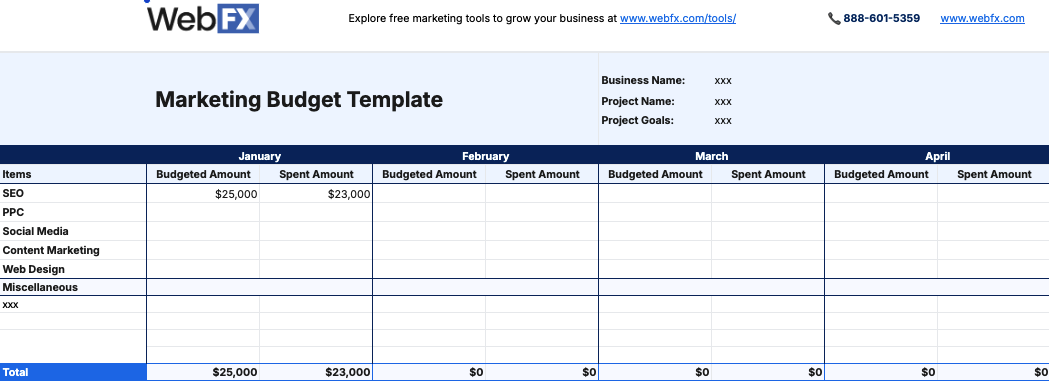-
 Published: Dec 30, 2024
Published: Dec 30, 2024
-
 17 min. read
17 min. read
-
 Macy Storm
Macy Storm Content Marketing Consultant
Content Marketing Consultant
- Macy is a content marketing consultant with over five years of experience creating content for dozens of industries including home services, recreation, and education. She’s written about every marketing topic under the sun, from SEO to AI to email marketing. Her work has been featured by Search Engine Journal, HubSpot, Entrepreneur, Clutch, and more. In her free time, Macy enjoys crafting, reading comic books, and walking her dog Daisy.
Key Takeaways
- Ensure your budget is used wisely by focusing spending on high-return channels, utilizing data for optimization, allocating budget for customer retention, and adapting to changing market trends.
- Keep a portion of your budget allocated for moonshots to help build new marketing channels
- Track campaign performance, leads generated, and ROI. Adjust spending as needed to optimize results.
- Consider industry, business age, and market type to gauge how much to allocate for marketing. However, always customize the budget to align with your business goals and strategy.
Wondering how to plan a marketing budget? Creating a marketing budget for your company may seem daunting, but it doesn’t have to be. A budget for marketing plans helps keep your strategy on track with your company’s overall finances, so you can reach your business goals.
On this page, we’re diving into six easy steps for how to create a marketing budget for 2025 to make your next planning session a breeze!
Here’s a quick overview of everything we’ll cover on this page:
- What is a marketing budget?
- How to plan a marketing budget for 2025 in 6 steps
- Marketing budget allocation
- How to calculate a marketing budget
- Tracking your marketing budget
- Common marketing budget mistakes
- How much do different industries spend on their marketing budget?
- Free marketing budget template
Try our free Marketing Calculator
Craft a tailored online marketing strategy! Utilize our free Internet marketing calculator for a custom plan based on your location, reach, timeframe, and budget.
Plan Your Marketing Budget
Industry-Specific Marketing Budget Guides
What is a marketing budget?
A marketing budget is an outline of the costs your company will spend to market or promote your brand, products, or services. A budget in marketing covers all the expenses of your marketing strategy for a finite period of time, which could be anywhere from a quarter to a year.
Watch: How to Plan a Marketing Budget
How to plan a marketing budget for 2025 in 6 steps
Now that you know why a marketing budget is essential, it’s time to look at how to prepare a marketing budget and prioritize it. Check out these six critical points you’ll want to establish to set up your marketing budget:
- Determine your business’s goals
- Establish your sales cycle
- Know your outside costs
- Understand your market
- Get an idea of what strategies you want to use
- Research strategy prices
1. Determine your business’s goals
Every guide on how to create a marketing budget will say that you must establish your business’s goals — and it’s true! You need to know what you want to achieve, so you can set a budget that allows you to achieve those goals. You can set goals that focus on:
- Earning more sales
- Increasing leads
- Earning more subscribers
- Increasing brand awareness
- And more
When you set your business’s goals, make sure they’re specific and smart. You don’t want to set a goal like “increase sales.” It won’t give you a precise target to work towards and achieve.
Instead, set a goal like “Increase sales by 20% by the end of the year” This goal is easily measurable and gives your team something precise to achieve. It’ll also give you a concrete reference point when budgeting for marketing because you know how much you want to increase sales by and the timeline for achieving that increase versus just knowing that you want to increase sales.
If you want to know how to prepare a marketing budget properly, start by adding your overall business goals so you can invest in the right marketing methods to help you reach your goals.
2. Establish your sales cycle
When you create your marketing budget plan breakdown, you want to establish your sales funnel. Your sales funnel is a critical component of your marketing budget because it determines where you’re going to spend your money. Your sales funnel is the process your audience goes through to become a paying customer. A typical sales funnel will have four stages:
- Awareness: At this stage, your audience becomes aware that they have a problem and starts looking for solutions.
- Consideration: At the consideration stage, your audience starts to look at the options available to them.
- Decision: When a lead reaches the decision stage, they start to narrow their focus on companies that provide the best solution or product for their needs.
- Action: Once a lead reaches the action stage, they choose your business and become a customer.
Understanding your business’s sales funnel helps you see where you may need a digital marketing strategy to help you keep more people from falling out of the funnel.
For example, let’s say you notice that your business’s funnel has a ton of people at the consideration stage, but very few make it to the decision stage. While some drop-off is natural, you notice that the decline is more significant than what you’d expect.
As a result, you may find that you need to budget more money for strategies that will help get leads from the consideration stage to the decision stage. Strategies like video marketing, pay-per-click (PPC) services, and social media ads may help you push those leads down the funnel.
So, to help you understand how much you need to budget for marketing, you need to understand your sales cycle. Knowing your sales cycle will help you anticipate strategies you need to invest in, which will help you budget for your marketing plan wisely.
3. Know your outside costs
If you want to know how to prepare a marketing budget plan, start by establishing your external costs. You need to know how much everything costs your company, so you know how much you can allocate for marketing. So, what are outside costs you need to consider?
- Operational costs (creating products, shipping them)
- Costs for employing staff
- Costs for running your business (electricity, water)
- And more
You must consider these costs when creating your marketing budget plan. Not only does it determine what services you can invest in, but it also helps you set a baseline for your return on investment (ROI).
So, for example, let’s say it costs your business $10 to produce your product. You sell your product for $50. So, when you’re choosing marketing methods for your business, you have an idea of how much you want to spend so you can still make a profit off your item.
This information will help guide you to strategies that allow you to get the best ROI for your business.
4. Understand your market
You need to know where you fit in your market to build an effective marketing budget plan. When you understand how you stack up against your competition, you can better establish which strategies you need to use to compete with them.
You’ll want to do a competitor analysis to see how your competition performs online. You can even use competitor analysis tools to help you see where your competition currently succeeds online. It can help you determine which strategies you’ll need to budget to drive success.
You can use a competitor analysis tool like CompetitorSpyFX to analyze competitor campaigns and get ideas for your own campaigns or use social media monitoring tools to keep track of what people say about competitors on social.
5. Get an idea of what strategies you want to use
An essential component of preparing a 2025 marketing budget is choosing your strategies. You don’t need to be 100% sure about the strategies you want to use, but you should have an idea of which strategies seem to be the best fit for your business. There are numerous digital marketing strategies you can use, including:
- Search engine optimization (SEO): SEO is the process of boosting your website’s rankings in search results to help drive more relevant, organic traffic to your page.
- Pay-per-click (PPC) advertising: PPC ads are paid advertisements that appear at the top of search results pages and on other web pages. These ads allow you to reach more leads that are ready to convert.

- Social media marketing: Social media marketing enables you to connect with your audience one-on-one and deliver informative content to them. This strategy allows you to build relationships with leads and nurture them into customers.
- Social media advertising: If you invest in social media advertising, you’ll focus on creating compelling ad copy targeted at specific leads. These ads appear seamlessly in their newsfeed, allowing you to build brand recognition and earn more leads.

- Email marketing: Email marketing enables you to nurture leads towards conversion by sending them tailored content that fits their interests. You can send promotional emails, exclusive deals, abandoned cart reminders, and more.

- Content marketing: Content marketing enables you to drive more leads to your page by sharing valuable information with your audience. Whether it’s blog posts or videos, you can share your knowledge with your audience and establish yourself as an authority in your field.
- Local SEO: With local SEO, you optimize for local keywords and claim your Google Business Profile listing to help drive more local traffic to your business. Below, you can see an example of a GBP listing!

- And more!
You’ll want to have an idea of which strategies you want to use for your business when creating a marketing budget. When you know which strategies you want to invest in, you can determine how they will fit into your marketing budget plan. That brings us to our next critical component of how to plan a marketing budget.
6. Research strategy prices
Whether you’re going to run your campaigns on your own, hire a freelancer, or hire a digital marketing company, you need to know how much it costs. Your marketing budget breakdown should focus on how much each strategy will cost your business. First, you must determine who you want to handle your campaign:
- In-house: If you decide to stick to your in-house team, the cost will come in the form of salaries and materials you need to execute your campaigns. You may still need to hire outside help or invest in tools that enable you to manage your campaigns.
- Freelancers: Freelancers are people who specialize in one type of strategy or dabble in a few of them. If you hire a freelancer, you’ll typically pay by the hour or on a per-project basis. The prices may be higher if the freelancer is more experienced or uses software, which they include in their rate.
- Digital marketing company: If you hire a digital marketing company, you’ll get everything you need, from tools to people. Unless you’re doing a one-off project, you’ll pay per month to keep a digital marketing company on retainer.
Typically, if you’re busy running your business, you’ll want to rely on a digital marketing company. It allows you to reap the benefits of having a marketing plan and someone to manage your budget, while you worry about other aspects of your business.
How much do professional digital marketing services cost? To help you get an idea, here’s a range of digital marketing pricing you should expect to pay for online marketing strategies from a digital marketing company:
- SEO: $500 – $20,000+ per month
- PPC: 5-20% of monthly ad spend
- Content marketing: $2000 – $20,000 per month
- Social media marketing: $250 – $10,000 per month
- Email marketing: $300 – $2500 per month
These prices will vary depending upon your business and what you need. But this range is about how much you can expect to pay if you partner with a digital marketing company.
By knowing these costs, you’ll know how to prepare a marketing budget better, so you can use the strategies that will drive the best results for your business.
Marketing budget allocation
A marketing budget allocation is the maximum amount of money you will spend on your marketing strategy. When budgeting for marketing, your allocation is the amount your budget can’t exceed.
Just like every business is different, so is their marketing budget allocation. Every business plans their marketing spend differently, based on what their marketing goals are, what channels their investing in, how they performed in the previous year, and more.
If you don’t set a marketing budget allocation, you could spend more than the desired amount on your campaigns.
The Moonshot Principle
One common mistake many people make when allocating their marketing budgets is they don’t take enough risk. It’s easy to over-rely on marketing channels that are proven performers for you. They’ve got the highest chance of dependable results and are likely the channels that you are most comfortable with. But what if I told you that you may be missing out on exponential performance lifts by not taking enough chance? We call this the Moonshot Principle.
The Moonshot Principle
Devote around 15% of your marketing budget to new, exploratory marketing channels to uncover future stable, reliable channels.
Taking these moonshots allows you to future proof your marketing strategy. It allows you to do some marketing R&D, if you will. Not all of your moonshots will work out, but by committing to the practice of trying new things in your marketing efforts, you’ll surely uncover some new channels that work and eventually become part of your stable, reliable channels that consistently provide the ROI you are looking for.
You can use your moonshot marketing budget allocation to do things like try advertising on up-and-coming social media networks, explore influencer marketing, launch a new account-based marketing campaign, test targeting new markets…the possibilities are endless.
You can get stable ROI by hammering away at your core marketing channels but working in a few moonshots opens up the possibility for exponential growth — something that a very conservative budget allocation won’t provide.
How to calculate a marketing budget
Now that you know how to plan a marketing budget, let’s explore how to calculate it. When it comes to creating a marketing budget, you’ll need to determine how much you should spend.
The U.S. Small Business Administration recommends that businesses that make less than $5 million annually should set aside about 8% of their gross revenue for their marketing plan budget.
However, it’s important to note that every business is unique, and you may spend more or less than this amount, depending on your company’s needs.
To create a goals-driven marketing budget plan, determine your target cost for acquiring a new customer and how many new customers you want to gain through your marketing.
Then, multiply those two numbers and add in any fixed costs.
For example, say your target cost-per-acquisition is $300 per customer, you want to acquire 200 new customers, and your fixed costs add up to $10,000. In that scenario, you’d use the following formula.
- (300 x 200) + 10,000 = 70,000
So, you’d need to allocate a total of $70,000 to marketing to achieve your customer acquisition goal. As you run your marketing campaigns, you can track the number of new customers you acquired and your cost per acquisition to determine how well your campaigns are working and what you might want to tweak to improve performance.
Tracking your marketing budget
Now that you know how to create a marketing budget and how much you should calculate when it comes to marketing budget planning, you’ll need to track your marketing budget over the course of the year or quarter to ensure you don’t overspend.
Follow these best practices for tracking your marketing budget plan so you can reach your business goals:
- Set a baseline or benchmark for the budget: Your baseline or benchmark is the planned cost and expense of executing your marketing strategy. By setting a baseline, you can have something to compare your spending to as time goes on to ensure you don’t overspend and adjust your spending as needed.
- Have a process in place for how team members spend your budget: You may have multiple team members that use the budget to purchase tools or platforms or launch advertisements. Ensure there is a process in place for everyone to follow and that your entire team understands how much they can spend.
- Track your campaigns: Keep a spreadsheet or use a platform like RevenueCloudFX, to track all of your marketing campaigns in one place. Note how much you’ve invested in each campaign and the return you receive from them.
- Track your leads: Keep track of the leads that enter your pipeline. Keep track of their source, the campaign that converted them to a lead, whether they converted to a customer, and the amount of revenue they generated for your company.
- Adjust your spending as necessary: Once you have a process in place for tracking your campaigns, leads, and spending, you can better understand which campaigns generate the most revenue for your company. As a result, you can funnel your budget to the strategies that drive the best results for your business. You can also adjust your spending if you find that you are spending too much on a particular campaign.
Common marketing budget mistakes
Here are a few common marketing budget mistakes you should avoid when planning and tracking your budget:
- Funneling spend to channels that don’t provide a high return: It’s essential to ensure that your marketing plan budget goes toward the channels that drive the most revenue for your business. Track the return on investment (ROI) of your strategies and ensure your budget goes to the campaigns that provide the highest return.
- Not using data to implement and optimize marketing campaigns: The success of your marketing strategy is only as good as your data. Ensure your budget is going to good use by tracking and analyzing campaign and audience data to constantly improve your strategies.
- Discounting current customers: It costs more money to acquire new customers than it does to keep current customers coming back. Make sure to allocate some of your budget toward retaining current customers and building customer loyalty.
- Using last year’s marketing budget: Audience’s needs and interests change year after year, which means your campaign spending will likely shift too. You need to reallocate your marketing budget every year — Don’t get stuck allocating the same spend to the same channels you did last year. Analyze current market trends and ensure your budget goes toward the channels your audience is utilizing most.
Read More About Marketing Budget Mistakes
How much do different industries spend on their marketing budgets?
Now that you know the formula for how to calculate a marketing budget, you might be wondering what other businesses in your industry tend to spend on their marketing strategy.
When it comes to how to determine a marketing budget, you can learn how much your business should budget for its marketing plan by looking at your industry and its average marketing spend in the table below.
| Industry | Marketing Budget (% of Company Revenue) |
|---|---|
| Communications media | 10% |
| Mining and construction | 3% |
| Service consulting | 21% |
| Consumer packaged goods | 9% |
| Consumer services | 6% |
| Education | 3% |
| Energy | 1% |
| Banking, Finance, Insurance, and Real Estate | 8% |
| Healthcare | 18% |
| Manufacturing | 13% |
| Retail wholesale | 14% |
| Technology | 21% |
| Transportation | 6% |
Besides industry, your business can also look at its age and the overall market. For instance:
- Age: Businesses between one and five years old should invest 12% to 20% of revenue toward marketing, and businesses older than five years should invest 6% to 12% of revenue toward marketing
- Overall market: Business-to-business (B2B) companies should invest 7% to 8% of revenue toward marketing, while business-to-consumer (B2C) companies should invest 9% of revenue toward marketing
Remember, though, that every company is unique. Considering your business’s goals when creating your budget is crucial. Depending on your organization’s goals and overall business strategy, you may opt to create a marketing plan budget that is higher or lower than your industry’s average.
Free marketing budget template
A marketing budget template can make creating your budget a breeze. Check out WebFX’s marketing budget template below!

“*” indicates required fields
If not, click here.
Start preparing your 2025 marketing budget plan today
If you’re ready to dive into creating your marketing budget plan and hire a marketing agency, WebFX is here to help. With 25+ years of experience, we know how to prepare a marketing budget that works for your business’s unique needs.
As a business marketing firm, we’ll help you choose strategies that work with your budget and drive results for your business. Whether you’re looking for SEO services, PPC services, web design services, or something else, we have you covered!
Contact us online or call us today at 888-601-5359 to learn more!
-
 Macy is a content marketing consultant with over five years of experience creating content for dozens of industries including home services, recreation, and education. She’s written about every marketing topic under the sun, from SEO to AI to email marketing. Her work has been featured by Search Engine Journal, HubSpot, Entrepreneur, Clutch, and more. In her free time, Macy enjoys crafting, reading comic books, and walking her dog Daisy.
Macy is a content marketing consultant with over five years of experience creating content for dozens of industries including home services, recreation, and education. She’s written about every marketing topic under the sun, from SEO to AI to email marketing. Her work has been featured by Search Engine Journal, HubSpot, Entrepreneur, Clutch, and more. In her free time, Macy enjoys crafting, reading comic books, and walking her dog Daisy. -

WebFX is a full-service marketing agency with 1,100+ client reviews and a 4.9-star rating on Clutch! Find out how our expert team and revenue-accelerating tech can drive results for you! Learn more
Try our free Marketing Calculator
Craft a tailored online marketing strategy! Utilize our free Internet marketing calculator for a custom plan based on your location, reach, timeframe, and budget.
Plan Your Marketing Budget
Table of Contents
- Industry-Specific Marketing Budget Guides
- What is a marketing budget?
- How to plan a marketing budget for 2025 in 6 steps
- Marketing budget allocation
- How to calculate a marketing budget
- Tracking your marketing budget
- Common marketing budget mistakes
- How much do different industries spend on their marketing budgets?
- Free marketing budget template
- Start preparing your 2025 marketing budget plan today

Proven Marketing Strategies

Proven Marketing Strategies
Try our free Marketing Calculator
Craft a tailored online marketing strategy! Utilize our free Internet marketing calculator for a custom plan based on your location, reach, timeframe, and budget.
Plan Your Marketing Budget
What to read next





